|
This newsletter is late, I know!
Goodbye to Meryl:
We were very sad to see Meryl Harrison once again leave the
country. She has put the plight of animals in Zimbabwe on the
global map and the animal welfare industry will be the poorer
for her departure.
Masvingo lions:
The recent saga with the Masvingo lions has just epitomized
the huge problem that exists in the Zimbabwean animal
welfare/conservation scene. Having recently read Richard
Leakey’s “Wildlife Wars”, it appears that it is a universal
problem in this innately emotive industry.
After our last visit to the lions in June 2012 when two of
them were trans-located to Bally Vaughan Animal Sanctuary, a
leading welfare organization lost their patience with the
‘softly softly’ approach and opened a cruelty docket against
the landowners. Since we had worked alongside this
organisation, when we offered to implant the remaining
lionesses with contraceptive devices in July (since some had
commenced mating behavior again) we were denied access to the
lions. Subsequently another welfare organization got involved
and brokered the release of 2 more lions from the facility. It
appeared all parties wished there to be no lion breeding, and
so wished us to implant the remaining lionesses with
contraceptives. However, it took 6 weeks of increasingly
acrimonious to-ing and fro-ing between all stakeholders to
actually get a signed letter from the landowners that AWARE
could work on the lions.
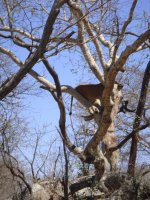 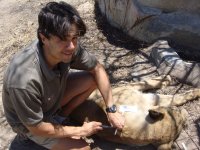 Finally on October 2nd, Keith and Erick made
the 330km trip to Masvingo and implanted the rest of the
females (19 in total this year), and immobilized 2 more for
translocation to Bally Vaughan. The working conditions were
treacherous once again due to inadequate management pens. Keith
had to dart a charging male (in order to get access to the
females) a couple of meters below a gaping hole in the fence.
Fortunately the lion seemed not to notice the hole, or else
Keith would have surely been killed. The last female ‘treed’
herself in the middle of the pen in an attempt to evade being
darted. Keith managed to dart her anyway and then ‘coax’ her
down the tree with some well placed mud-clogs before she fall
asleep. After an exhausting day the vets drove home only to be
woken the following morning by a call saying that the last
lioness had now escaped from her pen altogether and was sitting
in a tree near the workers’ compound. She faced being shot if
we did not react. Erick got back in his car, and drove the
330km again where he managed to get the lioness safely back in
the pen with an accurate dart. He returned to Harare at 11pm,
only to have his car broken into and some equipment stolen at
2am! No good deed goes unpunished! Finally on October 2nd, Keith and Erick made
the 330km trip to Masvingo and implanted the rest of the
females (19 in total this year), and immobilized 2 more for
translocation to Bally Vaughan. The working conditions were
treacherous once again due to inadequate management pens. Keith
had to dart a charging male (in order to get access to the
females) a couple of meters below a gaping hole in the fence.
Fortunately the lion seemed not to notice the hole, or else
Keith would have surely been killed. The last female ‘treed’
herself in the middle of the pen in an attempt to evade being
darted. Keith managed to dart her anyway and then ‘coax’ her
down the tree with some well placed mud-clogs before she fall
asleep. After an exhausting day the vets drove home only to be
woken the following morning by a call saying that the last
lioness had now escaped from her pen altogether and was sitting
in a tree near the workers’ compound. She faced being shot if
we did not react. Erick got back in his car, and drove the
330km again where he managed to get the lioness safely back in
the pen with an accurate dart. He returned to Harare at 11pm,
only to have his car broken into and some equipment stolen at
2am! No good deed goes unpunished!
Thanks go to Virbac/Peptech Australia who donated the
contraceptive implants, and Helen Fairnie for organizing them.
The lionesses will not be able to breed there for about 18
months. AWARE has taken the decision to suspend further free
veterinary treatment at this facility, as we feel that the
landowners should be paying for this service now.
Rhinos:
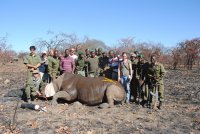 In late July AWARE completed 2 re-dehorning operations
in our National Parks where a total of 16 white rhinos were
safely dehorned. In late July AWARE completed 2 re-dehorning operations
in our National Parks where a total of 16 white rhinos were
safely dehorned.
These populations were last comprehensively dehorned in 2010
and we are pleased to say that both areas have not lost a rhino
due to poaching in that time. There have also been four births
in the one area within the last year.
There were some ‘interesting’ moments in the op, such as
when three big males absolutely refused to leave the side of a
female that we had darted, despite the helicopter buzzing
overhead. The ground team, including some veterinary student
volunteers and a crowd of PWMA rangers, had an adrenalin
pumping stand-off with the charging males, as we tried to
urgently get to the side of the immobile female before she had
anaesthetic complications. In the end a ranger had to fire two
shots into the air, and even then the bulls only retreated to a
distance of about 50m whilst we quickly dehorned the female and
woke her up again.
Sadly, a female rhino Carolina, and her calf, died due to
natural causes in one of the Parks. We were first called to
treat the calf whose mother had abandoned her in early July.
She was so weak she let us walk right up to her and inject her
with medication. She died the same night. The mother became
recumbent about 6 weeks later when we were in Kariba. Dr Rob
Rees was called to treat her and he managed to pump in 18
litres of fluid intravenously without any sedation (never a
good sign!). She too died overnight. We performed the post
mortem examination of this animal together with Dr Foggin of
the Wildlife Veterinary Unit. Her teeth were so eroded from old
age that when we showed the pictures to veterinary dental
specialist Dr Steenkamp, he was amazed that she had still been
alive and carried a calf with almost no teeth in her mouth. It
is a rare privilege for a rhino to die at such a ripe old age.
Well done to the Parks rangers for keeping her alive that
long.
APPEAL: We have been asked by PWMA to appeal for
donations for 3 solar powered borehole pumps for the area in
which we have our camera trap study. There is an imminent
drought looming in the southern half of the country and already
the black rhinos in this area are straying out of the park to
look for water, where they easily pick up snares in the
surrounding communal lands. By reviving the streams in the
middle of this park we will be able to contain the rhinos
within the park and greatly reduce the risk that these animals
will encounter outside the park where they are not protected by
teams of rangers. The pumps cost around $2500 each. Please
help.
Rehabilitation:
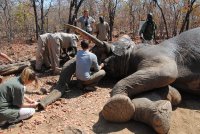 At the
request of the Kariba Animal Welfare Trust, in July we drove up
to treat an elephant on Antelope Island. This elephant had a
swelling beneath its eye, partially closing the lower lid and
an abscess on its inner foreleg. He was a massive bull with
huge tusks and went down from the dart in a sternal position,
which is a dangerous position for the anaesthetic as the
elephant’s weight impairs respiration. Due to a sharp mopane
stub next to the animal, we had to push him onto his right
side, which unfortunately meant we couldn’t get a good view of
the problem eye. Despite a crowd of us trying to roll the
animal after the mopane stub had been dealt with, he just
wouldn’t budge, so Lisa had to perform an ophthalmic exam and
administer treatment on her back under the massive beast’s head
like a mechanic under a vehicle. Keith meanwhile lanced and
cleaned out the abscess on his leg, and he was injected with
long acting antibiotics. He was the only elephant on Antelope
Island at that time. Cavan Warren went back to try and find him
the next day but he had vanished – he must have swum back to
the mainland overnight after we disturbed him. At the
request of the Kariba Animal Welfare Trust, in July we drove up
to treat an elephant on Antelope Island. This elephant had a
swelling beneath its eye, partially closing the lower lid and
an abscess on its inner foreleg. He was a massive bull with
huge tusks and went down from the dart in a sternal position,
which is a dangerous position for the anaesthetic as the
elephant’s weight impairs respiration. Due to a sharp mopane
stub next to the animal, we had to push him onto his right
side, which unfortunately meant we couldn’t get a good view of
the problem eye. Despite a crowd of us trying to roll the
animal after the mopane stub had been dealt with, he just
wouldn’t budge, so Lisa had to perform an ophthalmic exam and
administer treatment on her back under the massive beast’s head
like a mechanic under a vehicle. Keith meanwhile lanced and
cleaned out the abscess on his leg, and he was injected with
long acting antibiotics. He was the only elephant on Antelope
Island at that time. Cavan Warren went back to try and find him
the next day but he had vanished – he must have swum back to
the mainland overnight after we disturbed him.
In other rehab cases by AWARE, a weak and feverish zebra was
treated by Lisa and Keith at Lake Chivero National Park; a
stray zebra was rescued from a farm on the Shamva Road and
taken to Bally Vaughan; and 3 stray zebra on the Shamva road
were darted by Anton and Erick and loaded onto a Pioneer truck
for relocation to Umfurudzi Safari Area.
Donkeys:
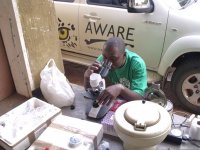 In June we were fortunate to have a volunteer vet
student from Cornell University, Kelsey Shaw, who, together
with Erick, carried out a donkey disease research project in
the tsetse infected region behind the Matusadona mountain
range. In addition to Erick’s normal clinics, the pair
collected blood samples from 200 donkeys to test for
Trypanosomosis (wet preps, Giemsa thick and thin blood
smears, buffy coat smears and FTA cards for PCR);blood protein
levels; and PCVs. Faecal samples were taken and worm egg counts
performed. Serum samples were taken for the later testing of
Brucellosis. A detailed social survey was also
performed. This data should elucidate the relationship between
poor body condition and symptoms like abortions and the
presence of disease, or worms, or just malnutrition. This will
make the clinics Erick performs better able to target the real
cause of a donkey that ‘just looks dull’, and not waste
valuable money treating something that may not be that
important. In June we were fortunate to have a volunteer vet
student from Cornell University, Kelsey Shaw, who, together
with Erick, carried out a donkey disease research project in
the tsetse infected region behind the Matusadona mountain
range. In addition to Erick’s normal clinics, the pair
collected blood samples from 200 donkeys to test for
Trypanosomosis (wet preps, Giemsa thick and thin blood
smears, buffy coat smears and FTA cards for PCR);blood protein
levels; and PCVs. Faecal samples were taken and worm egg counts
performed. Serum samples were taken for the later testing of
Brucellosis. A detailed social survey was also
performed. This data should elucidate the relationship between
poor body condition and symptoms like abortions and the
presence of disease, or worms, or just malnutrition. This will
make the clinics Erick performs better able to target the real
cause of a donkey that ‘just looks dull’, and not waste
valuable money treating something that may not be that
important.
In early September SPANA’s veterinary director Andy Stringer
visited the project and brought equine specialist Rachel
Conwell with him to talk at the Zimbabwe Veterinary
Association’s Annual International Congress, convened by Lisa
as part of the ZVA committee. Rachel and Andy visited Erick’s
clinics in Karoi and provided their usual expert guidance. We
hope that SPANA will be expanding the donkey project in 2013.
Erick will be attending a SPANA veterinary regional meeting in
Ethiopia in November.
Appeal:
Unfortunately due to a lack of finances we have not managed
to do a single spay campaign this year. Without better public
support AWARE cannot function optimally. Please renew your
membership for 2013 in December, and don’t forget the animals
at Christmas time!
Thanks:
Colcom
The Lloyds
SAVE Foundation
Virbac/Peptech Australia
Ali Travlos
Dave Bradshaw
Zoe Van Zyl
Charlie Pinkham
Marney Phear
Kelsey Shaw, Matthew Bridge and Gemma Campling
Debbie Davies
SPANA
Sabrina Jenrich
Nigel Hullet
Pam Marabini
Project Vets
Silent Heroes Foundation
KAWT
|